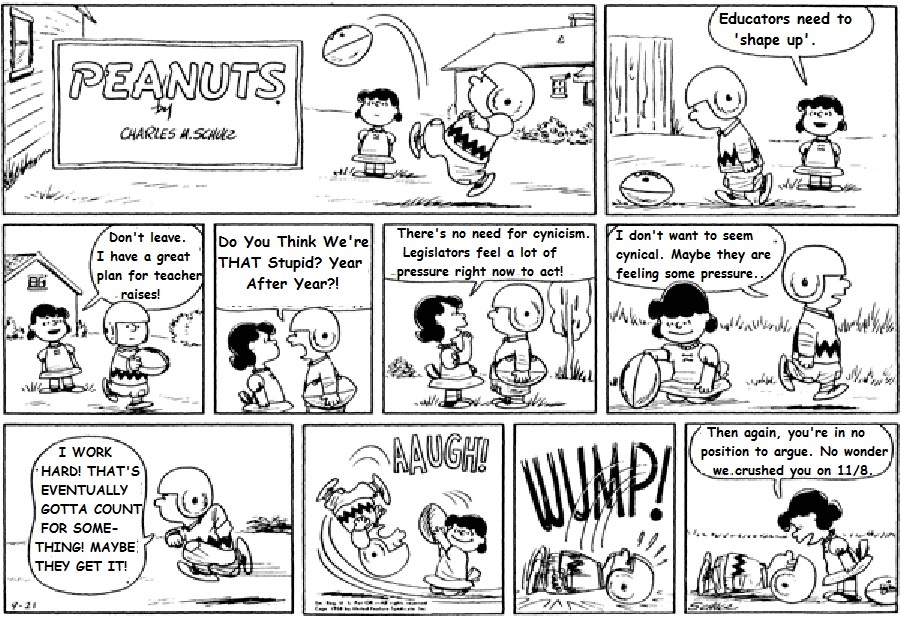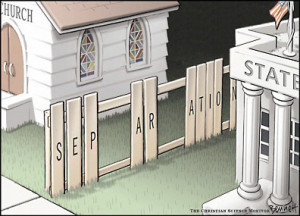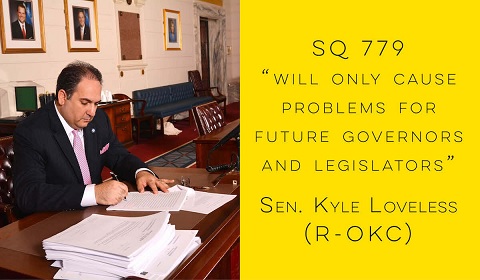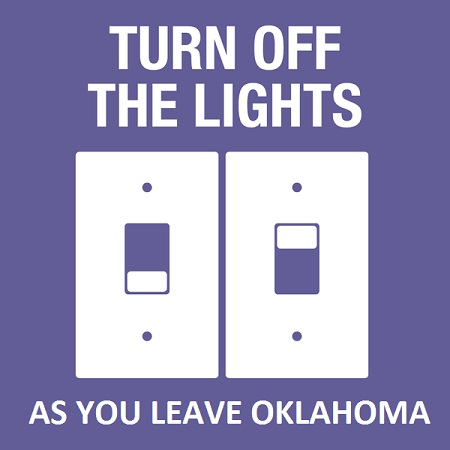 Teachers Are Delusional.
Teachers Are Delusional.
I don’t necessarily mean this in a bad way, although it does have a few downsides.
As you probably know, public education in general and teachers in particular were thoroughly rebuked in the recent state elections. SQ779 went down in flames after polling rather well only weeks before, largely due to the efforts of mysterious groups who appeared out of nowhere and began panicking on our behalf over the sad, if well-intentioned, error we were all clearly about to make.
They embraced the new, “reality-optional” approach so popular these days with an effective, two-pronged strategy. First, make up a bunch of stuff people could easily refute if they bothered to read the actual question but didn’t. Second, treat this 1% tax as a misguided starting point for growthful discussions rather than a desperate, if flawed, last-ditch effort to overcome a decade of one-party rule and overt hostility towards the idea that every kid deserves committed, effective educators dragging them towards enlightenment.
They promised a “better way,” which apparently involves disbanding and vanishing as soon as the votes were tallied.
Then again, I guess they didn’t say exactly who it was better for.
Smirking legislators quickly joined the chorus of assurances that of course they’d immediately be doing everything they possibly could to give teachers huge raises, first thing! For totes realsies this time! Why would we doubt them? They’re our government – they live to serve!
In their defense, legislators have no real reason to do anything about teacher pay or school funding in general. Incumbents responsible for draconian tax cuts and vocal belittling of all things government-financed were re-elected almost universally, often by landslide margins. They’d be silly to change course now – it’s working.
For them, I mean.
 Stubborn advocates insist they’ll be calling their elected officials weekly, demanding they do something about school funding – which, let’s face it, is adorable! I can hear the conversation now: “If you don’t do something this session, next time we’re only re-electing you back into office by a twenty percent margin! And the time after that could dip as low as a fifteen! Also, you should come visit my class! I made muffins! We’re forming relationships!”
Stubborn advocates insist they’ll be calling their elected officials weekly, demanding they do something about school funding – which, let’s face it, is adorable! I can hear the conversation now: “If you don’t do something this session, next time we’re only re-electing you back into office by a twenty percent margin! And the time after that could dip as low as a fifteen! Also, you should come visit my class! I made muffins! We’re forming relationships!”
No doubt legis find this hopeful yapping amusing, if not exactly endearing – at least until tiny pedagogists pee on their leg in excitement.
Many teachers have already left, or changed professions. Many more are looking to go. We’ve always lost a percentage of edu-graduates to surrounding states, but now we’re having trouble keeping any of them. You know things are bad when we’re not as civic-minded as, say… Texas.
Texas. We’re not as focused on equity and the social contract and the value of modern education as TEXAS.
What’s more shocking, though, is how many teachers are staying. Doubling down. Resolving to do everything they can to make this the “best year yet”! Holding assemblies, bake sales, and smothering Donate.org with requests. Personally, I find this to be the worst sort of enabling – of protecting and encouraging bad behaviour. As several of my therapists over the years were fond of saying, “They won’t change until you stop making THEIR problems YOUR problems, and let THEIR problems be THEIR problems.”
 Or maybe that was Dr. Phil. They all kinda blur together.
Or maybe that was Dr. Phil. They all kinda blur together.
So why is it that teachers and other educators are so quick to believe that this time Lucy really will hold that football until it’s kicked? Why are we so quick to embrace the mantra that we can change our elected abusers with our love – and that if we’d only put a little more makeup on that bruise, maybe this time they’ll love us back?
It’s the nature of the profession. You can’t be a successful public school teacher for any length of time unless you embrace a certain amount of denial and delusion. You don’t expect musicians to be on time. You don’t expect surgeons to be humble and self-effacing. No way you can expect teachers to be bound by reality. They’d never last.
Why?
1. We spend our day chasing the idea that we’re somehow reaching 150 very different kids with very different backgrounds, needs, and abilities. We utilize our personal skill sets as best we can (while always on the lookout for better ideas), but in the end it’s just us flinging possibilities around and hoping some of them take.
Making this work requires a healthy dose of self-delusion. What’s really crazy is how often it does succeed, and so much better than it should.
2. We embrace curriculums and guidelines not usually of our own design, circumscribed by rules and procedures certainly not of our own making. We take whatever we’re assigned and decide it will be meaningful, and engaging, and good for kids – their druthers and ours be damned.
This isn’t as entirely misguided as it sounds. Most any subject or skill has merit, depth, and meaning if you dig enough – but it does require a certain degree of inner adjustment. Selling yourself and your kids on, say, the academic value and personal fulfilment of analyzing the Battle of Honey Springs takes a bit of imagination. It demands taming a few chimeras. And if you don’t believe it, they’ll never buy into it.
Although, if you think about it, that particular battle really did have some fascinating elements that –
You know what? Never mind.
 3. Surviving in the world of public education requires an ability to go through the motions of countless state and district-mandated trainings, reports, and meetings about what you teach and how you teach it and what we’re calling it this year – all without ending up under your desk in a fetal position, clutching a shiv made out of dry erase markers, daring anyone to say “flipped classroom” to you ONE MORE TIME.
3. Surviving in the world of public education requires an ability to go through the motions of countless state and district-mandated trainings, reports, and meetings about what you teach and how you teach it and what we’re calling it this year – all without ending up under your desk in a fetal position, clutching a shiv made out of dry erase markers, daring anyone to say “flipped classroom” to you ONE MORE TIME.
It requires embracing and adapting to ever-shifting evaluations of your kids and of what you do – a bedlam of rotating standards and priorities and trends and buzzwords. Usually without Dramamine.
You want to flourish in that alternate reality? Unleash the ignis fatuus.
4. Finally, a career in education requires looking beyond the tangible, the visible, the measureable, with an almost religious faith. Maybe fanaticism.
Of course the numbers matter. Of course the data has its uses. We’re delusional – not ignorant.
But if faith is the substance of things hoped for, and the evidence of things not seen, then teaching requires a great deal of it. If you ARE doing any good, you’re unlikely to see the most important results during the nine months those kids are yours. If you ARE making a difference, in that silly, idealistic way you signed up for back-in-the-day when choosing between this or veterinary school, you’ll never actually KNOW that for a fact.
It’s not that kind of difference.
So yeah, we’re a bit quick to believe, even when we know better. And I do get annoyed by the naiveté shown by those who so easily and repeatedly trust elected leadership, wealthy reformers, or anything cloaked in lofty ideals.
But that’s the trade-off, I guess. If we were realists, we’d all be selling shoes or doing your taxes or something.
So delusional it is.


 We’ve been looking at Zelman v. Simmons-Harris (2002), the case most often cited when I’m researching vouchers and their constitutionality.
We’ve been looking at Zelman v. Simmons-Harris (2002), the case most often cited when I’m researching vouchers and their constitutionality.  Here’s a fun little game. Go to
Here’s a fun little game. Go to 
 As discussed
As discussed 
 This is where I wonder if the lack of actual
This is where I wonder if the lack of actual  Ohio’s program is constitutional because of all of the non-religious alternatives promoted by the state. If parental choice means a majority of kids end up in religious schools, that’s fine – as long as it’s the result of true choice. That means a variety of accessible options, both religious and non, public and private.
Ohio’s program is constitutional because of all of the non-religious alternatives promoted by the state. If parental choice means a majority of kids end up in religious schools, that’s fine – as long as it’s the result of true choice. That means a variety of accessible options, both religious and non, public and private. 




 This addresses the second prong of the “
This addresses the second prong of the “


 The Oklahoma GOP has for some time now held unchecked control of both the State Legislature and the Governor’s chair. Voters have handed them the keys, a 12-pack of Keystone, and encouraged them to have their way with the state. You’ve no doubt noticed the resulting prosperity trickling down all around you.
The Oklahoma GOP has for some time now held unchecked control of both the State Legislature and the Governor’s chair. Voters have handed them the keys, a 12-pack of Keystone, and encouraged them to have their way with the state. You’ve no doubt noticed the resulting prosperity trickling down all around you.
 Actually, this being Oklahoma, I should clarify further. “Are vouchers an effective way to provide a better education for a greater variety of students in a fiscally realistic way?” That’s how they’re promoted ‘round these parts, but I’m not at all convinced that’s the actual goal. (See earlier disclaimer about the humble guy with a blog.)
Actually, this being Oklahoma, I should clarify further. “Are vouchers an effective way to provide a better education for a greater variety of students in a fiscally realistic way?” That’s how they’re promoted ‘round these parts, but I’m not at all convinced that’s the actual goal. (See earlier disclaimer about the humble guy with a blog.) 
 But you can’t legislate community buy-in, and you can’t mandate teacher satisfaction or require people to stay in the profession. The public wouldn’t pass bonds to pay for stuff, and district school boards wouldn’t make hard choices about cuts. Add school-board drama, conflicts over school closings and program cuts, and the ever-looming issue of racial equity, and despite many good people mostly pursuing what they thought was right, it just… they couldn’t…
But you can’t legislate community buy-in, and you can’t mandate teacher satisfaction or require people to stay in the profession. The public wouldn’t pass bonds to pay for stuff, and district school boards wouldn’t make hard choices about cuts. Add school-board drama, conflicts over school closings and program cuts, and the ever-looming issue of racial equity, and despite many good people mostly pursuing what they thought was right, it just… they couldn’t… 


 New candidate Mickey Dollens (D) took HD93, no doubt through his genuine commitment to the district and his unmatched work ethic. (His opponent’s ability to personally alienate and horrify almost everyone in the district over the past decade probably didn’t hurt, either.) Forrest Bennett (D) won HD92 and Chris Kidd (R) SD31. So… that’s something.
New candidate Mickey Dollens (D) took HD93, no doubt through his genuine commitment to the district and his unmatched work ethic. (His opponent’s ability to personally alienate and horrify almost everyone in the district over the past decade probably didn’t hurt, either.) Forrest Bennett (D) won HD92 and Chris Kidd (R) SD31. So… that’s something.  But it’s time for #OklaEd to get the message. You are not wanted here. The vast majority does not think you’re worth even what you make now, and they certainly don’t think most of your kids deserve any better. Strong percentages say “we could fix education if only these teachers weren’t in the way” or “those damned districts have been given too much without accountability.” And they believe it. To paraphrase their patron saint, “Public education is not the solution to the problem; public education is the problem.”
But it’s time for #OklaEd to get the message. You are not wanted here. The vast majority does not think you’re worth even what you make now, and they certainly don’t think most of your kids deserve any better. Strong percentages say “we could fix education if only these teachers weren’t in the way” or “those damned districts have been given too much without accountability.” And they believe it. To paraphrase their patron saint, “Public education is not the solution to the problem; public education is the problem.” 
 We’re largely to blame. We’ve proven year after year that we don’t vote in meaningful numbers, or if we do, we vote our fears instead of our ideals. We jump and bark and pee on their legs every time they dangle “Pay raise! Pay raise! We’ve really got a plan for a Pay Raise! Come get it, boy! That’s a good constituency!”
We’re largely to blame. We’ve proven year after year that we don’t vote in meaningful numbers, or if we do, we vote our fears instead of our ideals. We jump and bark and pee on their legs every time they dangle “Pay raise! Pay raise! We’ve really got a plan for a Pay Raise! Come get it, boy! That’s a good constituency!” 

